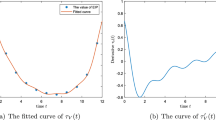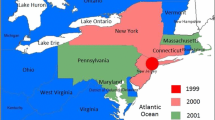Abstract
A two-patch model for the spread of West Nile virus between two discrete geographic regions is established to incorporate a mobility process which describes how contact transmission occurs between individuals from and between two regions. In the mobility process, we assume that the host birds can migrate between regions, but not the mosquitoes. The basic reproduction number \(R_{0}\) is computed by the next generation matrix method. We prove that if \(R_{0}<1\), then the disease-free equilibrium is globally asymptotically stable. If \(R_{0}>1\), the endemic equilibrium is globally asymptotically stable for any nonnegative nontrivial initial data. Using the perturbation theory, we obtain the concrete expression of the endemic equilibrium of the model with a mild restriction of the birds movement rate between patches. Finally, numerical simulations demonstrate that the disease becomes endemic in both patches when birds move back and forth between the two regions. Some numerical simulations for \(R_{0}\) in terms of the birds movement rate are performed which show that the impacts could be very complicated.









Similar content being viewed by others
References
Abdelrazec A, Lenhart S, Zhu HP (2014) Transmission Dynamics of West Nile virus in mosquito and Corvids and non-Corvids. J Math Biol 68:1553–1582
Anderson JF, Main AJ (2006) Importance of vertical and horizontal transmission of West Nile virus by Culex pipiens in the Northeastern United States. J Infect Dis 194:1577–1579
Arino J, Davis JR, Hartley D, Jordan R, Miller JM, van den Driessche P (2005) A multi-species epidemic model with spatial dynamics. Math Med Biol 22:129–142
Arino J, Jordan R, van den Driessche P (2006) Quarantine in a multi-species epidemics model with spatial dynamics. Math Biosci 206:46–60
Auger P, Kouokam E, Sallet G, Tchuente M, Tsanou B (2008) The Ross-Macdonald model in a patchy environment. Math Biosci 216:123–131
Campbell GL, Marfin AA, Lanciotti RS, Gubler DJ (2002) West Nile virus. Lancet Infect Dis 2:519–529
Capasso V (1993) Mathematical structures of epidemic systems, vol 97. Lecture notes in biomathematics. Springer, Berlin
Cosner C, Beier JC, Cantrell RS, Impoinvil D, Kapitanski L, Potts MD, Troyo A, Ruan S (2009) The effect of human movement on the persistence of vector-borne diseases. J Theor Biol 258:550–560
Cruz-Pacheco G, Esteva L, Montaño-Hirose JA, Vargas C (2005) Modelling the dynamics of West Nile virus. Bull Math Biol 67:1157–1172
Diekmann O, Heesterbeek JAP, Metz JAJ (1990) On the definition and the computation of the basic reproduction ratio \(R_0\) in models for infectious diseases in heterogeneous populations. J Math Biol 28:365–382
Drebot MA, Barker R et al (2003) West Nile virus surveillance and diagnostics: a Canadian perspective. Can J Infect Dis 14:105–114
Dye C, Hasibeder G (1986) Population dynamics of mosquito-borne disease: effects of flies which bite some people more frequently than others. T R Soc Trop Med Hyg 80:69–77
Gao DZ, Ruan SG (2012) A multipatch malaria model with logistic growth populations. SIAM J Appl Math 72:819–841
Goddard LB, Roth AE, Reisen WK, Scott TW (2003) Vertical transmission of West Nile virus by three California Culex (Diptera: Culicidae) species. J Med Entomol 40:743–746
Guo HB, Li MY, Shuai ZS (2006) Global stability of the endemic equilibrium of multigroup SIR epidemic models. Can Appl Math Q 14:259–284
Hadeler KP, Castillo-Chavez C (1995) A core group model for disease transmission. Math Biosci 128:41–55
Hadeler KP, van den Driessche P (1997) Backward bifurcation in epidemic control. Math Biosci 146:15–35
Hasibeder G, Dye C (1988) Population dynamics of mosquito-borne disease: persistence in a completely heterogeneous environment. Theor Popul Biol 33:31–53
Lewis M, Renclawowicz J, van den Driessche P (2006) Traveling waves and spread rates for a West Nile virus model. Bull Math Biol 68(1):3–23
Lin ZG, Zhu HP (2017) Spatial spreading model and dynamics of West Nile virus in birds and mosquitoes with free boundary. J Math Biol 75:1381–1409
Liu R, Shuai J, Wu J, Zhu H (2006) Modeling spatial spread of West Nile virus and impact of directional dispersal of birds. Math Biosci Eng 3:145–160
Malkinson M, Banet C, Weisman Y, Pokamunski S, King R, Drouet MT, Deubel V (2002) Introduction of West Nile virus in the Middle East by migrating white storks. Emerg Infect Dis 8:392–397
Rappole JH, Derrickson SR, Hubalek Z (2000) Migratory birds and spread of West Nile virus in the Western Hemisphere. Emerg Infect Dis 6:319–328
Rodriguez DJ, Torres-Sorando L (2001) Models of infectious diseases in spatially heterogeneous environments. Bull Math Biol 63:547–571
Simon CP, Jacquez JA (1992) Reproduction numbers and the stability of equilibria of SI models for heterogeneous populations. SIAM J Appl Math 52:541–576
Smith DL, McKenzie FE (2004) Statics and dynamics of malaria infection in Anopheles mosquitoes. Malar J 3:13–26
Torres-Sorando L, Rodriguez DJ (1997) Models of spatio-temporal dynamics in malaria. Ecol Modelling 104:231–240
van den Driessche P, Watmough J (2002) Reproduction numbers and sub-threshold endemic equilibria for compartmental models of disease transmission. Math Biosci 180:29–48
Author information
Authors and Affiliations
Corresponding author
Additional information
This work is partially supported by NSERC and CIHR of Canada, the National Natural Sciences Foundation of China (11331009, 11301491, 11501339), Shanxi Scholarship Council of China (2014-020), the One Hundred Talents Project of Shanxi Province.
Rights and permissions
About this article
Cite this article
Zhang, J., Cosner, C. & Zhu, H. Two-patch model for the spread of West Nile virus. Bull Math Biol 80, 840–863 (2018). https://doi.org/10.1007/s11538-018-0404-8
Received:
Accepted:
Published:
Issue Date:
DOI: https://doi.org/10.1007/s11538-018-0404-8




